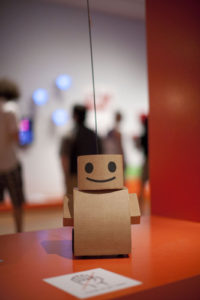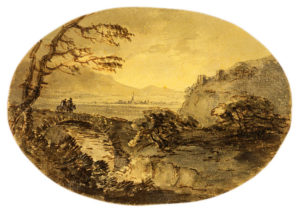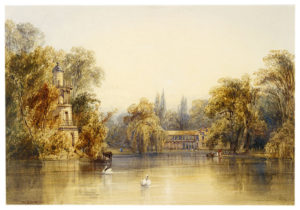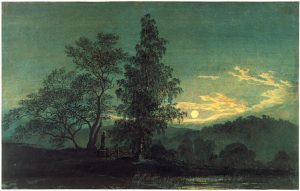There is a hellish alchemy in the documentary displays at the 9/11 Memorial Museum. The terrible events of 9/11 made art and history out of everything it touched, turning office workers into martyrs, emergency responders into tragic heroes, and utilitarian objects – steel beams, airplane parts, fire trucks – into mythic relics. In such a context, artistic statements seem almost superfluous.

Twisted beam from the Twin Towers at 9/11 Memorial Museum.
Perhaps that is why the museum has waited till now, two years into its existence, and 15 years after the attacks, to mount its first art exhibit. The challenge for an artist here is to take this vividly documented public narrative and turn it into something intimate and personal.
So, the curators of “Rendering the Unthinkable: Artists Respond to 9/11,” have assembled 13 artists who were personally touched by or at least physically close to Ground Zero. One lost a brother. Others lost friends. Several watched the events unfold from their Lower Manhattan studios. One was so close as to be literally buried by the tsunami of ash and debris that blew out the glass in his windows. Others were farther away, but still close enough to pick up the scraps and sheets of office paper that drifted down from the sky.
For all of these New York-based artists, the attacks were a local event, not just something seen on TV or read about in the papers. Most of the pieces were made in the immediate aftermath, when the shock was still fresh and when such an event really was “unthinkable.”
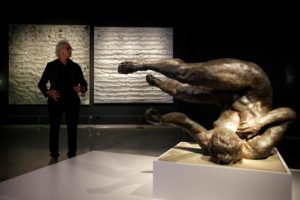
Artist Eric Fischl next to his controversial sculpture, “Tumbling Woman.”
In fact, so raw were the wounds, that the initial public response to one of these works was that it was unlookable. Eric Fischl’s “Tumbling Woman,” displayed on the concourse of Rockefeller Plaza in 2002, prompted such public outcry that it was covered, then removed within a week. The life-size bronze depicts a nude woman, upside-down, at the moment of impact with the ground. She is far from tumbling. The work refers to “the jumpers” – those who fell or jumped to their deaths from the flaming towers. And, although the muscular, androgynous body makes her seem more allegorical than real, the subject was seen as too searing and confrontational for a public space.
It remains to be seen what people will say now that it’s displayed in a gallery, albeit a very public one.
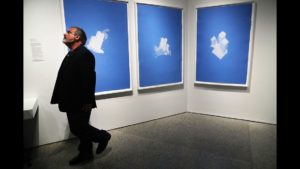
Most of the works in this show shy away from the human figure. That of Christopher Saucedo, whose brother Gregory was a firefighter killed in the collapse of the North Tower, is an austere, abstract work of handmade paper. Titled “World Trade Center as a Cloud,” it is a white form that, floating on a pure blue background, vaguely evokes the blockish skyscrapers.
Also from a first responder family is Colleen Mulrenan MacFarlane. Her father, a deputy fire chief who had been working at Ground Zero, came home after three days. Her video, titled “daughter, sept 13,” shows her hands scrubbing her father’s white shirt. The purpose was for him to be able to return to the site, but the act seems ritualistic, as if the compulsive cleaning could wipe away the event and protect the shirt’s wearer.
This is probably the most personally felt art in the show. Most of the others are too remote from human emotion. Twins Doug and Mike Starn are among those who made use of the floating-papers motif. They superimposed decaying leaves over the sheets of scorched office paper. The effect is elegant and elegiac, but hardly an impassioned statement.
Something is likewise lacking in the four-minute video of falling papers by the performance collective Blue Man Group. The image, in which the sheets drift gracefully through a black void like a snowstorm at night, is, with its upbeat soundtrack, more lovely than sad.
It’s as if many of the artists could not bear to engage too closely with their intense subject. Donna Levinstone’s tiny pastels of rose-colored clouds of ash and dust are seen from such a distance, like dim and fading sunsets, that the effect is ethereal and unreal.
Of the artists who were close to the falling buildings, several mixed ash into their paintings. Todd Stone’s watercolor, “Lifting,” evokes that moment when, it was reported, pigeons took flight just before the first plane hit.
Abstract expressionist Michael Mulhern, who was temporarily buried in his ninth-floor studio by the debris from the collapsing south tower, mixed the ash into two gray, brooding compositions. The paintings are nearly 8-foot square and are on paper affixed to canvas, so that the surface ripples, like waves on water. Mulhern died in 2012.
Although the stories behind their creation are compelling, the art in this show is generally less so. Too many of these artists took a cerebral approach. Putting ash in the paint is not a substitute for emotional expression.
Then, too, it’s hard for art that is subtle or abstract to compete with the often sensational documentary material here – the twisted I-beams, crushed firetrucks, and videos of the collapsing towers just outside the glass walls of the gallery. Ironically, the 9/11 Memorial Museum may not be the best place to display art that deals with its subject.

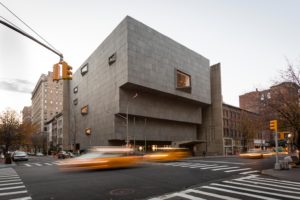


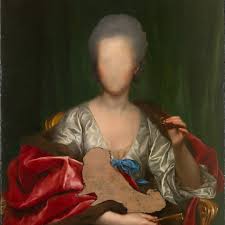

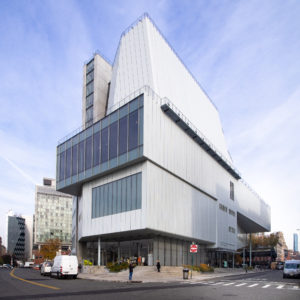
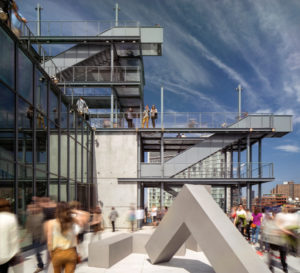
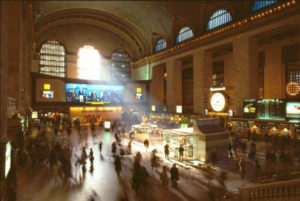 As a kid growing up in the early 60s, I used to take a train to Connecticut to visit my father. The adventure would begin at Grand Central station, where, after saying goodbye to my mother, I’d be on my own. I’d buy my ticket, get some magazines and gum, then hang around the Main Concourse, feeling very adult. I suppose I looked at the famous four-faced clock, though I didn’t know it was anything special.
As a kid growing up in the early 60s, I used to take a train to Connecticut to visit my father. The adventure would begin at Grand Central station, where, after saying goodbye to my mother, I’d be on my own. I’d buy my ticket, get some magazines and gum, then hang around the Main Concourse, feeling very adult. I suppose I looked at the famous four-faced clock, though I didn’t know it was anything special.


